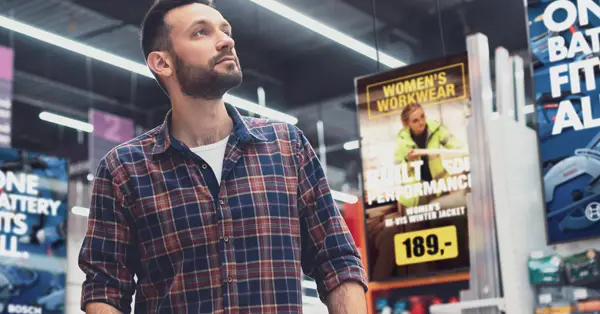Common factors for Successful In-Store Retail Media Businesses
Retailers excel in supply chain and inventory management, as well as in understanding consumer needs and responding to changing demands. However, media represents a new business area that demands different skills and a significant amount of learning.
When managing in-store retail media networks, it’s inevitable that you’ll face complex, multidimensional business challenges. Therefore, it’s clear that there isn’t a single model that will suit all retailers’ businesses and operating models.

Still, there are common factors that can be identified in the most typical cases of building successful, complex in-store retail media networks. Let’s explore the three most important ones.
1. Centralized decision making on capex related issues
When launching an in-store retail media business, one of the first questions that arises is how to cover the investment needed to build the network and acquire the required hardware.

The organizational models of large retailers vary widely. Some operate only a few chains, where decisions are made collectively, while others manage multiple chains across different retail sectors, with decentralized ownership structures.
In-store retail media represents a new business model for retailers, and launching any new venture comes with challenges that intensify with each additional layer of decision-making.
When organizing for in-store retail media, we always recommend that retailers consider a centralized decision-making model, at least during the network’s building phase. This approach significantly shortens the timeline to operational launch.
2. Multiple media sales models ran in parallel
In-store retail media can be sold through multiple models.
A typical large retailer aims to elevate their co-op efforts with trade partners by offering self-service options for managing tactical in-store campaigns.
Additionally, many retailers want to establish a media sales channel, either managed internally or in partnership with an external provider. Advertisers are primarily the brands sold in-store, but increasingly include non-endemic advertisers—those promoting products and services not available on the shelves.
Programmatic media sales are also a hot topic, though not yet a primary sales channel due to factors like the technological maturity of programmatic platforms for physical spaces. Over time, however, it is expected to grow significantly.
The key to success here is recognizing that parallel sales channels will typically be necessary for in-store retail media, and each must be developed to meet evolving customer demands.
While it’s fine to start with a single channel to test and learn, all sales models should be part of your roadmap.
3. Centralized Data Management as the Engine of Success
In-store retail media has quickly gained global popularity for two main reasons. First, retailers possess unique customer insights, enabling them to target the right customers at the right moments and deliver relevant messaging. Second, when advertisements appear at the point of purchase, their direct impact on sales is easier to track.

The unifying success factor in both of these strengths is data. Retailers’ first-party data is invaluable for understanding customer behavior. Therefore, when designing an in-store retail media network, data and insight should be at the foundation.
Unfortunately, many retailers don’t prioritize this as much as they should. Often, building an in-store retail media network is seen solely as a matter of network setup and sales. Even some tech-savvy retailers may view in-store retail media as akin to digital out-of-home networks placed indoors, with data merely as an added feature to fine-tune campaign distribution.
Retailers who build in-store retail media networks on a solid data architecture, however, can sell media across countries, chains, and audiences seamlessly—and they often achieve significantly higher revenue. A centralized audience approach enables retailers to analyze campaign performance, identify areas for improvement, and make data-driven adjustments to maximize future sales. This not only supports their clients’ success but also allows for measurable, data-backed results.
What Tools Are Needed to Tackle the Complexity?
What tools, then, does a large multinational retailer need to effectively manage the complex in-store retail media business, especially when it spans multiple chains, business units, and often several continents?
First, as mentioned earlier, it's essential to establish a centralized, efficient decision-making process for in-store retail media. This could be a dedicated unit, or a task force composed of members from different parts of the organization. Most importantly, this group must have both the authority, and the resources needed to drive results.

Second, you need a platform to manage functions across chains, borders, and business units. Centralized data management and media sales tools that integrate with local systems are essential. This setup allows the in-store retail media business to operate smoothly, regardless of the varying stages of development across chains, countries, and regions. The centralized platform should provide tools and dashboards that enable you to create value both across organizational and geographical boundaries as well as locally.
Third, common guidance is crucial to support different parts of the organization as they build their in-store networks. Stakeholders at various maturity levels need advice on hardware, platforms, operations, and business setup. Additionally, a feedback loop is essential, allowing stakeholders to learn from each other’s experiences.
Finally, reliable business and technology partners are key. Their experience and expertise will help you implement strategies effectively. The size and complexity of your organization should not prevent you from engaging in retail media and unlocking this major new in-store revenue stream.







